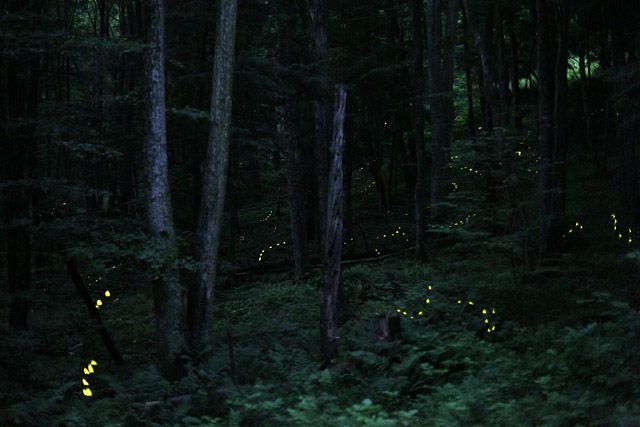Neatorama |
- Spend An Entire Weekend In America’s Culturally Riches Cities For Only $50
- Winning $2 Million By Mistake
- A man with practically nothing still manages to make incredible things happen
- Can You Find The Noseless Jack-o-Lantern?
- Josh Sundquist's Halloween Costume 2020
- How Fireflies Can Help In Improving Robot Communication
- Is There “Free Will”?
- Lying And How A Lie Detector Works
- Halloween Hijinks
- A Cat Aims For The Carp Inside Of Ice
- An Artist With Synesthesia Animates Bach’s “Prelude In C Major”
- The Creepy Windsor Ruins
- Sasabonsam Enforced the Rules of Renewal in West African Forests
- Why Is The Earth’s Magnetic North Pole Moving?
- When You Hit A Cyclist With Your Car On A Mountain Pass
| Spend An Entire Weekend In America’s Culturally Riches Cities For Only $50 Posted: 31 Oct 2020 05:42 AM PDT
I'd say this offer is a steal even in a non-pandemic timeline, but if you have the opportunity, maybe this offer will be of interest to you! Travel company Booking.com is offering $50 weekend-long stays — to represent the unity of the 50 states — at 10 select hotels in culturally rich neighborhoods as part of its America Is for Everyone campaign. Clients who take advantage of the promo will be able to experience the destinations with a "custom-designed and safety-first itinerary" in order to "enjoy authentic meals, historical tours, and more unforgettable experiences," as Travel and Leisure details: The destinations include hotels in the Vietnamese neighborhood of Factors Row in New Orleans; Little Ethiopia in Silver Spring, Maryland; Greektown in Tarpon Spring, Florida; Germantown in Frankenmuth, Michigan; the Dutch area of Oak Harbor, Washington; Little Haiti in Miami; Little India in Jersey City, New Jersey; the Mexican Cultural District in Denver; the Japanese area of Honolulu; and the Danish Village in Solvang, California. "In these challenging times, it's important to remember that it's the diverse backgrounds, cultures, and perspectives representing so much of the world that have made this country what it is today," Booking.com's senior vice president and chief marketing officer, Arjan Dijk, said in a statement. "We hope the 'America Is For Everyone' experiences help quench Americans' collective curiosity and inspire travelers to seek out new experiences they may not have realized existed so close to home." Image via Travel and Leisure |
| Posted: 31 Oct 2020 05:41 AM PDT
Samir Mazahem thought that he was saving numbers on the lottery app. What he had done, however, was very different from what he thought he was doing. Apparently, he had just bought an extra ticket with the same numbers that he had picked for the previous ticket that he bought. When he realized that he spent an extra $2 for the June 9 Mega Millions Game, he got upset. But he didn't think much about it. But his mistake turned out to be a blessing in disguise. As he logged on recently, he found out that he had two $1 million winners. "I couldn't believe it was real," Mazahem said. "It took several days for the reality to set in that my mistake had paid off to the tune of $2 million!" He recently claimed his prize and plans to buy a new house and save the rest. Lucky guy. (Image Credit: Pixabay) |
| A man with practically nothing still manages to make incredible things happen Posted: 31 Oct 2020 05:41 AM PDT
Limited money. No friends. No associates. No job. But, this guy still managed to put out an incredible music video with some great acting skills included. Click here for his incredible video. Make sure to like and follow. |
| Can You Find The Noseless Jack-o-Lantern? Posted: 31 Oct 2020 04:16 AM PDT
In this sea of carved pumpkins, there is one that is slightly different from the others. Unlike its peers, this one doesn't have a nose. Can you find where it is? This puzzle was made by Hungarian artist Gergely Dudás, who is also known online as Dudolf. If you found it, congratulations. And for those of you still craving more, we also have this other visual puzzle from Dudás featuring a lone ghost hiding within an army of skeletons. Via Mental Floss (Image Credit: Dudolf/ Mental Floss) |
| Josh Sundquist's Halloween Costume 2020 Posted: 31 Oct 2020 12:53 AM PDT
|
| How Fireflies Can Help In Improving Robot Communication Posted: 31 Oct 2020 12:53 AM PDT
It was an early June evening, and two scientists, physicist Raphael Sarfati and computer scientist Orit Peleg, can be found deep in the forest trail in Great Smoky Mountains National Park, bringing with them gear that is vital to photographing their subject, like butterfly nets, and GoPro cameras. Their subject: fireflies who turn on and off their lights in sync with each other. Unlike many firefly species that flash in individualized patterns for months every summer, these special fireflies display in a specific, collective pattern that the scientists wanted to track. With their tent and cameras set up and dusk descending, the sporadic blinking of individual fireflies harmonized into synchronous flashing. "They are everywhere around you. You can't even count how many there are, all flashing at the same time for a few seconds and then they all stop at the same time as well. It's dark and then it picks it up again," Sarfati says. "It's really astonishing." But why fireflies? Their study, it turns out, would be helpful in improving robot communication and synchronization in the near future. Learn more details about this study over at Smithsonian Magazine. (Image Credit: Radim Schreiber/ Wikimedia Commons) |
| Posted: 31 Oct 2020 12:53 AM PDT
1983. American physiologist Benjamin Libet invited some people to participate in his experiment. It was an experiment that would spark interest in psychologists, philosophers, and even neuroscientists. The study itself was simple. Participants were connected to an apparatus that measured their brain and muscle activity, and were asked to do two basic things. First, they had to flex their wrist whenever they felt like doing so. Second, they had to note the time when they first became aware of their intention to flex their wrist. They did this by remembering the position of a revolving dot on a clock face. The brain activity Libet was interested in was the "readiness potential", which is known to ramp up before movements are executed. It wasn't the experiment that was controversial. Rather, it was the findings. Through his experiment, Libet found out that the "participants' brains had already "decided" to move, half a second before they felt consciously aware of it." This seems to support the argument that there is no self that is distinct from the brain. In other words, there might be no such thing such as "free will". But is that really the case? Know more about this controversial study over at The Conversation. What are your thoughts about this one? (Image Credit: waldryano/ Pixabay) |
| Lying And How A Lie Detector Works Posted: 31 Oct 2020 12:53 AM PDT
For a person who is not used to lying, the said activity could be very stressful for him. When he lies, his respiratory and heart rate will increase. But why is this the case? Lying generally involves more effort than telling the truth, and because of this, it involves the prefrontal cortex. A 2001 study by late neuroscientist Sean Spence (University of Sheffield in England) explored fMRI images of the brain while lying. This is what the polygraph, more commonly known as the "lie detector", is used for — to provide continuous readings of a person's blood pressure and respiration rate, elements in one's body which could indicate if that person is lying or not. But can someone outsmart the polygraph? The answer is yes. … for example, psychopaths, who lack empathy… do not exhibit the typical physiological stress responses when telling a lie. This doesn't mean, however, that we should deem the polygraph as something unreliable. According to the American Polygraph Association (made up largely of polygraph examiners), the estimated accuracy of a polygraph can be up to 87 percent. That means that in 87 out of 100 cases, the polygraph will be able to detect if someone is telling the truth. Learn more about the polygraph, as well as what happens to a person when he lies, over at Big Think. (Image Credit: Federal Bureau of Investigation/ Wikimedia Commons) |
| Posted: 31 Oct 2020 12:51 AM PDT
|
| A Cat Aims For The Carp Inside Of Ice Posted: 30 Oct 2020 05:40 PM PDT
This cat just wanted a tasty treat while it's outside! Well, its owner tried their best helping, sure, by tapping the ice where the desired fish was trapped. Watch the short video of a cat trying to get a carp out of the ice. I'm sure it wasn't able to get the carp. Hopefully its owner gave it a treat when they got home! |
| An Artist With Synesthesia Animates Bach’s “Prelude In C Major” Posted: 30 Oct 2020 05:40 PM PDT
Israeli artist Michal Levy, who has synesthesia, created a short animation set to different classical pieces, such as Bach's 'Prelude in C Major', and Coltrane's 'Giant Steps.' Levy saw the "rollicking notes" of Coltrane's Giant Steps as a "kinetic, cascading cityscape built from colourful blocks of sound" and was able to visualize it. Levy then created the short animation 'Dance of Harmony' to show what she sees when she hears Bach's 'Prelude in C Major,' as Open Culture details: During a maternity leave, working with her friend, animator Hagai Azaz, she set herself the challenge of showing, as she describes it, "the cascading flow of emotion, to make the feeling contagious, by using only color, the basic shape of circles, and minimalist motion, assigning to each musical chord the visual elements that correspond to it synaesthetically." It is fascinating to compare Levy's descriptions of her condition with those of other famous synesthetes like Vladimir Nabokov and, especially Kandinsky, who in essence first showed the world what music looks like, thereby giving art a new visual language. Levy calls her synesthesia art, an "emotional voyage of harmony," and includes in her visualization of Bach's famous prelude an "unexpected elegiac sidebar of love and loss," Maria Popova writes. Read Levy's full description of Dance of Harmony here and learn more about the "extraordinary sensory condition called synesthesia" here. Image via Open Culture |
| Posted: 30 Oct 2020 05:39 PM PDT
The Windsor Ruins, located in the tiny town of Port Gibson, Mississippi, is one of the most sought after sites, frequented by locals and tourists. The site, which consists of just twenty-three Corinthian columns, is believed to be haunted by the ghost of a Union soldier who was killed on the property, as Only In Your State details: Smith Coffee Daniell II, Windsor's owner, is also said to haunt the grounds. According to one report, a visitor saw a man in period clothing, assumed it was a re-enactor, and approached to ask some questions about Windsor. However, as he got close, the "re-enactor" turned toward the man, smiled, and faded away. The strange happenings don't end there, though. It's said that on some nights, sounds of a long-ago party can be heard. Image via Only In Your State |
| Sasabonsam Enforced the Rules of Renewal in West African Forests Posted: 30 Oct 2020 05:39 PM PDT
Among the Akan people of West Africa, rules passed down from generation to generation show how to be respectful of the earth itself. One rule is that you do not go into the forest on Thursday. No hunting and no farming, because Thursday is a sacred day for the gods to find solitude. That day of rest is enforced by a deity called sasabonsam, a fierce being with glowing eyes and terrifying teeth who will destroy those who flout the rule, or maybe send them back traumatized and damaged as a warning to others.
The legend of sasabonsam has gone through some changes, particularly when Christian missionaries needed an understandable stand-in for the devil. Read about sasabonsam as he was originally conceived at Atlas Obscura. |
| Why Is The Earth’s Magnetic North Pole Moving? Posted: 30 Oct 2020 05:39 PM PDT
The British explorer James Clark Ross was the first one to determine the position of the magnetic North Pole in June 1831. At his time, he found it at Cape Adelaide on the Boothia Peninsula. At that time, it was already known that the magnetic pole moves, but in a slow manner. Seventy-two years later, in 1903, the Norwegian explorer Roald Amundsen found the magnetic North Pole again, albeit in a slightly different position. Over the next 90 years, the pole would move northwards at a rate of up to 15 kilometers per year. Then, in 1990, it suddenly began to accelerate northwards. In 2017, it passed the geographic North Pole and is now heading south towards Siberia. Scientists usually update the position of the magnetic pole every five years. But in 2019, the movement was so fast and unexpected that scientists were forced to issue an extra, irregular update so that navigation devices that rely on it could be corrected. What causes the sudden acceleration of the magnetic North Pole? Find out the answer over at Discover Magazine. (Image Credit: Nietjuh/ Pixabay) |
| When You Hit A Cyclist With Your Car On A Mountain Pass Posted: 30 Oct 2020 05:39 PM PDT
It is one thing to hear about stories about bikers getting hurt, or even killed, by drivers. You get angry and you get frustrated about drivers upon hearing these stories. It is another thing, however, when you get to see the story unfold with your own eyes — when you get to be the driver, who happened to seriously injure a biker on the road. When Brooke Warren experienced this, she realized that anyone could be "that driver." It was a traumatizing, but enlightening, experience for her. Read about Warren's story over at Outside Online. (Image Credit: Alexas_Fotos/ Pixabay) |
| You are subscribed to email updates from Neatorama. To stop receiving these emails, you may unsubscribe now. | Email delivery powered by Google |
| Google, 1600 Amphitheatre Parkway, Mountain View, CA 94043, United States | |















No comments:
Post a Comment
Keep a civil tongue.